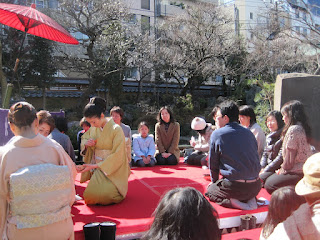Both, the most popular parks for hanami in Tokyo, these locations were where I would have taken overseas tourists as part of my sightseeing courses if had not been for the massive earthquake and tsumami that hit the Tohoku region in my country on March 11.
Although there were few foreign sightseers a large number of locals like me descended on the parks. In the Chidorigafuchi area including the Yasukuni Shrine, the cherry blossom festival has been cancelled and the municipal government has banned parties and food stands, and it has decided not to turn on the lights on the area at night- a measure of strict electoric austerity.
In Ueno Park the government seemed to be more generous; there were a lot of food stands and some small parties taking place under the cherry trees. But no one was drinking heavily or singing karaoke. The usual euphoria that is visible during this period was absent. With voluntary restraint, a fantastic attraction in addition to the cherry blossoms is a pair of panda bears in Ueno Zoo. The lovely animals, "Riri" and "Shinshin," sent by China two months ago were exhibited to the public on April 1. Thousands of kids and parents or grandparents have since queued at the gate of the zoo every day.
I took photos to post on my Facebook because I wanted to show them to my overseas friends who are saturated in the news words on Japan of disaster, devastation, radiation, evacuation and so on. Frankly, I'm not intelligent enough to know how harmful for my health the radiation exposure in Tokyo is because the stories are very complicated. Now the people like me have started to return to normal. It's time to end the panic and resume hanami.
 |
| Ueno Park |
 |
| Ueno Zoo |
 |
| Toshogu Shrine in Ueno Park |
 |
| Chidorigafuchi Park |





















